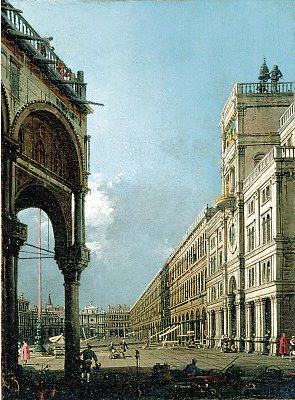 |
|
VENICE : PIAZZA SAN MARCO, FROM CAMPO SAN
BASSO
Giovanni Antonio Canaletto Italian
1697-1768
SN 186 Oil on Canvas 1760's
by Robert Anderson
ARTIST
Canaletto was the most famous view painter of the 18th century. He
began work painting theatrical scenery but turned to topography (verduto) early in his
career during a vistit to Rome when he was influenced by the work of Panini. By 1723 he
was painting dramatic and picturesque views of Venice, marked by strong contrasts of light
and shade and free handling.
Meanwhile partly under the influence of Carlevaris and largely in
rivalry with him Canaletto began to turn out views which were more topographically
accurate, set in a higher key and with smoother and more precise handling -
characteristics that mark most of his later work. Canaletto certainly saw Luca Carlevaris'
capriccio's and imaginary harbor scenes during his formative years in Venice. Some of his
early townscapes appear to have been adapted from engravings and even from paintings by
Carlevaris, supporting the hypothesis that after his return from Rome to Venice he spent
some time in Carlevaris' studio. |
By 1725-26 he was very much in demand as a specialist of Venetian
townscapes and was particularly skilled at "making the sun shine" in his
pictures. It was his custom to prepare his paintings outdoors 'on the spot' and 'not at
home after an idea' as was Carlevaris' practice.
His patrons were chiefly English collectors for whom he sometimes
produced series of views of uniform size. Joseph Smith an English merchant and British
Consul encouraged Canaletto enlarge his repertory to include capricci. In 1746 he went to
England and for a time was very successful, painting views of London and various country
houses. In 1755 he returned to Venice where he continued active for the remainder of his
life.
Canaletto was highly influential in Italy and elsewhere. Even in its
mechanical phases his work is much more than a mere factual record; and by his unobtrusive
skill in design, and his power of suffusing his work with light and air, he may justly be
regarded as one of the precursors of 19th century landscape painting.
SUBJECT
This painting of Venice depicts the Piazza San Marco seen from Campo
San Basso.
PAINTING
The picture is from a building's shadow out into the piazza. People
stand on the balcony of the building to the right while artisans are at work and merchants
sit under their awnings with their wares. There is blue sky with bright sunlight but storm
clouds are approaching.
The painting has been dated during the last decade of the artist's
life. The mechanical type of spot highlighting is characteristic of Canaletto's later
works.
HISTORICAL CONTEXT
In the 18th century noble families of England usually sent their sons
on a "Grand Tour" of the continent as part of their education. The trip might
take several years and was often taken with a tutor. Paintings such as the two Canalettos
were typical of the paintings in demand by these tourists as souvenirs of their travels.
|
